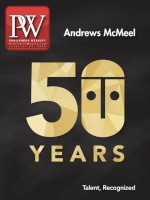What does environmentalism look like now, compared to that of the ’60s granola types?” asks Overcup v-p Rachel Bell. She’s describing Ground Truth (Apr.), a book of essays by Ruby McConnell that tracks the rise of environmental awareness in the Pacific Northwest and heralds a “postmillennial environmentalism.” It’s one among several forthcoming books that together examine environmentalism and conservation in the U.S. from the 19th century to the present.
Decades before a full-fledged environmental movement arose in the 1970s, Pulitzer Prize–winning novelist Louis Bromfield advocated for the now widely discussed practice of sustainable agriculture. A new biography, The Planter of Modern Life by Stephen Heyman (Norton, Apr.), describes Bromfield’s fight against industrial farming beginning in the 1930s and his success with the experimental Malabar Farm in Ohio, where he lived until his death in 1956.
“Bromfield is such a beguiling character,” says Norton v-p and executive editor Alane Mason. “There’s a lot of gloom and doom out there, and Bromfield found a way to live a life that was full of pleasure through a sense of mission and taking care of the Earth. There’s something very appealing about that.”
Where Bromfield spread awareness about the issues he cared about through his farm, conservationist George Grinnell (1849–1938) advocated for wildlife preservation as editor of Forest & Stream magazine (now Field & Stream), and helped establish Glacier National Park. A Grinnel biography, The Father of American Conservation by Thom Hatch, is due from Turner in February.
“We thought a book about someone who was dedicated to protecting the environment so early on would be a nice way to ground the Earth Day conversation in history,” says Heather Howell, managing editor at Turner, adding that Hatch takes an apolitical approach.
“He prompts readers to keep an open mind, to question the things we hear now and to think about them from Grinnell’s perspective—to go beyond thinking about the politicized climate change [discussion] to show how conservation has shaped the American West.”
Geography lessons
Other books focus on a particular landscape with an eye toward understanding people’s relationship to their environment and what Earth’s history has to say about its future. In Magdalena (Knopf, Apr.), anthropologist Wade Davis travels through farm towns and fishing communities dependent on Colombia’s Rio Magdalena and observes devastating damage along the way. PW’s starred review called the result a “rich, fascinating study of how nature and a people shape each other.”
Davis’s book is an eco-conscious travelogue. In contrast, Bjørn Vassnes’s Kingdom of Frost (Greystone, Mar.) introduces readers to the charms and wonder of the forbidding Arctic climate that he once called home.
“It’s important to the author to share the fascinating science of the cryosphere,” says Greystone marketing manager Megan Jones, using a term that refers to all of the planet’s frozen water. Vassnes, who grew up in a remote part of northern Norway, “shows why the cryosphere is so important to all life on Earth, even if you live thousands of miles away from it,” Jones says. “This book offers amazing scientific reporting, such as on what people are doing to protect the cryosphere in Siberia, and ends on a message of hope. He invites us in, rather than making us afraid of the potential outcome.”
Ben Ehrenreich’s Desert Notebooks (Counterpoint, July) leads readers through the beauty of another harsh climate, with a mix of science, anthropology, and memoir drawing on time he spent in Joshua Tree, Calif., and around Las Vegas. His writing conveys a “visceral experience of being in the desert,” says Counterpoint v-p and editor-in-chief Dan Smetanka. “The book braids nature writing with a cultural history of how other people and cultures have dealt with this idea of the end of time, such as Native American legends and other histories of societies on the brink.”
Another region that has dealt with its share of apocalyptic reckoning is the Pacific Northwest, following the 1980 eruption of Mt. Saint Helens. In Ground Truth, McConnell explores the rise of environmentalism in the region following the eruption and frames environmental movements as a generational conversation.
“It was really around that time that people noticed the massive logging happening, and several Superfund sites were designated due to water pollution,” Bell says. McConnell writes about “the boomers contaminating because they didn’t know better, and how we moved from that era to millennials, where we’re starting to recognize that every piece of land is essential.”
Internal affairs
With The Inner Coast (Norton, June), Donovan Hohn captures what Norton v-p and senior editor Matt Weiland calls “a 19th-century American sensibility toward nature.” Weiland was eager to work with Hohn after reading 2011’s Moby-Duck, which PW’s starred review said was “packed with seafaring lore and astute reporting.” In the new book, Hohn explores his relationship to the environment through essays whose subjects include his passion for collecting old tools, a meditation on water as a natural resource, and his California upbringing.
Novelist John Rember, in A Hundred Little Pieces on the End of the World (Univ. of New Mexico, Mar.), finds relief from facing the climate crisis through short reflections on literature. “Fiction has the power to keep us alive, which is why we all practice creating it,” he writes. The short essays are organized into sections covering dark humor (“Is Civilization Too Dumb to Live?”), philosophy (“Eating with Peter Singer”), and hopeful speculations about a postapocalyptic future. PW’s review said, “Rember’s sometimes dark, sometimes humorous book of reflections dispenses hard-earned wisdom on a world in crisis.”



 Volume 267
Issue 6
02/10/2020
Volume 267
Issue 6
02/10/2020





